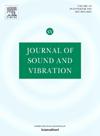Three-dimensional free vibrations of piezoelectric spherical shells filled with non-Newtonian fluids
IF 4.3
2区 工程技术
Q1 ACOUSTICS
引用次数: 0
Abstract
The dynamic interaction between piezoelectric structures and complex fluids is critical due to their widespread use in devices operating within complex fluid environments. This study investigates the three-dimensional (3D) free vibration behavior of a piezoelectric spherical shell filled with a non-Newtonian fluid, accounting for both shear and compressional relaxation effects. The linearized generalized Navier–Stokes equations in spherical coordinates are solved analytically by introducing appropriate velocity potential functions. Based on linear piezoelectricity theory, the governing equations for torsional and spheroidal modes are decoupled via three displacement functions and solved using the generalized Frobenius power series method. By enforcing the interface continuity conditions of the fluid–structure coupling system, complex characteristic frequency equations for the two classes of free vibrations are ultimately formulated. The complex vibration frequencies are computed using the Muller iteration algorithm. The proposed methodology is validated through comparative analysis with existing literature. Numerical examples are presented to examine the influences of fluid viscosity, fluid viscoelasticity, and spherical shell size on the vibration frequency and quality factor. The 3D analytical solutions developed in this study provide a theoretical basis for analyzing the vibrations of piezoelectric spherical containers and resonators filled with complex fluids, with promising applications in engineering and biomedicine.
充满非牛顿流体的压电球壳的三维自由振动
压电结构与复杂流体之间的动态相互作用是至关重要的,因为它们广泛应用于复杂流体环境下的设备中。本文研究了非牛顿流体填充的压电球壳在考虑剪切和压缩松弛效应的情况下的三维自由振动行为。通过引入适当的速度势函数,对球坐标系下线性化的广义Navier-Stokes方程进行了解析求解。基于线性压电理论,通过三个位移函数解耦扭转模态和球模态的控制方程,并采用广义Frobenius幂级数法求解。通过强化流固耦合系统的界面连续性条件,最终建立了两类自由振动的复杂特征频率方程。采用Muller迭代算法计算复振动频率。通过与现有文献的比较分析,验证了所提出的方法。通过数值算例分析了流体粘度、流体粘弹性和球壳尺寸对振动频率和质量因子的影响。本研究开发的三维解析解为分析充满复杂流体的压电球形容器和谐振器的振动提供了理论基础,在工程和生物医学领域具有广阔的应用前景。
本文章由计算机程序翻译,如有差异,请以英文原文为准。
求助全文
约1分钟内获得全文
求助全文
来源期刊

Journal of Sound and Vibration
工程技术-工程:机械
CiteScore
9.10
自引率
10.60%
发文量
551
审稿时长
69 days
期刊介绍:
The Journal of Sound and Vibration (JSV) is an independent journal devoted to the prompt publication of original papers, both theoretical and experimental, that provide new information on any aspect of sound or vibration. There is an emphasis on fundamental work that has potential for practical application.
JSV was founded and operates on the premise that the subject of sound and vibration requires a journal that publishes papers of a high technical standard across the various subdisciplines, thus facilitating awareness of techniques and discoveries in one area that may be applicable in others.
 求助内容:
求助内容: 应助结果提醒方式:
应助结果提醒方式:


